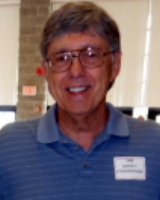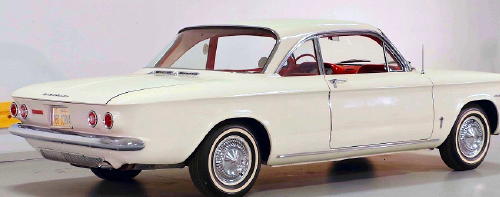SIDNEY UNDERWOOD - GLOVE BOX MONEY
 By Sidney Underwood
By Sidney UnderwoodI grew up in Calhoun County, during the 1950s. After graduating from high school in 1960, I knew that I wanted to go to college. My parents finances were tight and Glenville State was the closest college. It seemed to be the most reasonable choice for me given the low cost of tuition which was about $120.00 per semester. Also, the fact that Glenville was only 20 miles from Grantsville played a part in my familyâs decision for me to commute there.
My dad suggested that we purchase a new fuel efficient car for me to drive to Glenville. I was certainly on board with that idea. At that time Volkswagen Beatles were very popular cars and I assumed that a Beatle would be the car of choice. Dr. Toepher had the first one that I ever saw. This would have been around 1950. I remember seeing it and thinking it looked like an Army helmet on wheels! Dr.Toepher told everyone that it really went well in the mud and snow when he made home visits.
I said to dad that Jim Wegman of Parkersburg was the nearest Volkswagen dealer. I remember he had a weekly advertisement in the Calhoun Chronicle that stated a new Volkswagen Beatle could be had for $1995.00 with an AM radio. But my dad had other ideas. He wanted me to have a car made in America that would be fuel efficient. In his mind, it had to be a Chevy Corvair or Ford Falcon, both of which could be purchased in Grantsville.
At that time Chrysler had a small car made in France called a Simca. It was available through Arnold Motor Sales of Grantsville. Dad dismissed it as not being a real car as he had serious concerns about French automobiles. He favored the Corvair and arranged for us to test drive one. He was good friends with Ted Burch, the local Chevy dealer. We test drove a Corvair four door sedan and it handled very well.
Bud Hathaway was a mechanic who worked for Ted Burch Chevrolet. He explained to us on the day of the test drive that it was very important to check the air pressure on the Corvairs tires monthly. Even though all the tires were the same size, he told us the front tires should have 16 pounds of air pressure while the rear tires needed 26 pounds. He said that if we over inflated the front tires, the car would not handle well and would be dangerous to drive since most of the weight was in the back.
Ralph Nader published a book entitled, UNSAFE AT ANY SPEED in the late 1960s. In that book he was critical of the handling characteristics of the Corvair. From my own experience with my car for the eight years I owned it, I never had any handling problems. Of course, I always made sure the tire pressure was correct. Naders book was the beginning of the end for the Corvair and production ceased in 1969.
I remember Ted Burch called us in June of 1960 and said he had just received a Corvair Monza coupe. I remember when I first saw it sitting in the showroom, I was impressed. It was a neat looking car with a red interior, bucket seats and narrow white wall Firestone Champion tubeless tires. The decision was made quickly and I invested my life savings of $500.00 into a down payment. Dad financed the remainder. He and the bank now owned a new 1960 Corvair with me as the principal driver. The fact that my first car was new was not lost on me. I was a very lucky young man indeed. I had seen other young men drive their first cars. Most of those cars were ten of twelve years old and worn out and beat up. Some of them were unsafe and were constantly breaking down along the road.

My car had a flat six cylinder air cooled motor mounted over the rear drive wheels with a three speed manual shift on the floor. I think it was rated at 80 horsepower. It had none of the features we take for granted today such as air conditioning, power windows or even a radio. Nevertheless, I loved that car. But, it did have one unique feature and that was a gasoline heater located in the trunk just above the spare tire in the front of the car. It had its own sparkplug and worked great. The gasoline heater was an extra cost option, but well worth the fifty dollars. Over the following eight years, many times when I parked the car during winter months, the heater would keep making a buzzing sound until the excess gasoline was used up. This resulted in people often telling me that I had failed to shut off the motor. Each time that occurred, I would explain that the heater used gasoline and eventually would shut off all by itself.
When school started that August, I began the daily routine of travelling State RT#5 to Glenville. The road at that time was much neglected. It had been patched many times with tar and shale and was notorious for pot holes and craters. The road was so bad that I ran along at 48 mph giving me plenty of time to avoid the bad places. I remember Dick and Bill Barnes commuting to school at that time. They drove an old Plymouth Wagon and usually passed me on the straight at the Calhoun Gilmer line. More than once I watched while that old Plymouth bounced and slammed through the bad sections of road.
During the winter months, my Dad had snow tires installed on my car. With the weight of the motor over those heavy cleated tires, the car had excellent traction in bad weather. Those tires proved to be a wise investment as I never missed a day of school.
Since I was not the only commuter from our town attending college at Glenville, soon others asked to ride with me. My Dad stated that I could not legally charge anyone to ride, but should encourage them to make contributions to a gas fund by putting money into the cars glove box. I had many riders over that four year period and the glove box money certainly helped with the fuel costs.
The road to Glenville had only one hill and it was located three miles above Grantsville with the unusual local name of Hog Knob. The name, I suppose, dated back to some farmers wayward livestock. Hog Knob could be treacherous on snowy winter mornings especially when I had 8:00 AM classes. It would sometimes be necessary for me to leave home at 7:00AM and encounter that hill well before the DOH had plowed and treated the road. On those mornings, my routine was always the same. I would gain as much speed as possible in second gear as I approached the hill and If I encountered no obstructions, I would keep going gradually easing up on the throttle so I would not break traction and finally crawling across the summit. I had learned by experience that if I started up that hill in high gear and attempted to shift down, I would lose traction and spin out. Travelling down the other side had its heart pounding moments also. I would stay in second gear and let the motor hold me back. But, as the car slowly gained speed it would become necessary to apply the brakes and then release them in order to regain control of the steering before it started yawing sideways. This scenario was played out many times during winter months and there were some exciting white knuckle moments when encountering spinning sideways cars on the wrong side of the road! I came to think of Hog Knob as my own personal nemesis that would someday get me. My premonition would later prove to be valid but in a much different way than I could have imagined.
At Glenville State the semester finals involved two hour exams for each class. Sometimes I would be unlucky enough to have three exams the same day. One can only imagine the draining effect of sitting for six hours and totally concentrating on the various subjects. After these sessions, I would arrive back at Grantsville and suddenly realize that I had no memory of the drive. It was as if some sort of auto pilot had taken over. Or, perhaps, like the postmans horse, the car had guided me while I was preoccupied with rethinking the test questions.
During the spring semester of 1963, for whatever reason, there were no riders and no glove box money to help pay for the gas. By being careful with my expenses, I had managed to save a small amount of money for the upcoming weekend. I started home from Glenville one sunny afternoon in April with not much gas in the tank.
I figured maybe three gallons of gas were still in the car. And, at 24 mpg, I calculated that I should get home ok. The gas gauge was hovering almost on empty. All went well for the first 17 miles until I started up Hog Knob hill. The car suddenly started losing power and moments later quit dead. I instantly knew that I was out of gas. My old nemesis had finally gotten me. I coasted the car backward unto the berm. I sat there for several minutes thinking of how stupid I was and what to do now. Finally, I got out of the car and walked down the hill to the nearest house and knocked on the door. A kindly old lady answered and graciously allowed me to use her phone. My Dad answered on the first ring and listened patiently to my plight. Okay was all he said. I thanked the lady and walked back up the hill to wait by my car. In about 20 minutes dads Plymouth came into sight. He pulled over and produced a can of gas from his trunk. I remember it was very quiet standing there that sunny day and I seemed to hear my heart beating in my throat while he poured gas into the Corvair. I knew enough to be quiet and to wait.
After he placed the empty gas can back in his trunk and closed it with a resounding thump, he turned to me and demanded, Show me your wallet. Startled by his forcefulness, I handed it to him. He looked in it and tossed it back to me. You have money, you aren't broke, and why in the hell didn't you buy gas in Glenville before you started home? I remember that I could not think of a logical response as I studied the guardrails behind the car. Still deeply in thought over fashioning a sensible answer, I was interrupted by his words, If this ever happens again, don't bother to call me, as far as I'm concerned, you can just walk home! With that final statement, he got into his car and left, not waiting to see if the Corvair would start. But, it did start and I drove on home. That evening I was careful to keep my distance from him. My mom noticed that I was unusually quiet at the dinner table and asked if I was feeling alright. I assured her that all was fine. I realized that dad had not told her about our encounter and so I didnât mention it either.
I still remember that long ago incident on Hog Knob every time I stop to purchase gas. And I learned a dear lesson that day. Would you believe in the 57 years since that moment in time, I have never allowed my gas tank to be empty? Dad would be proud of me.